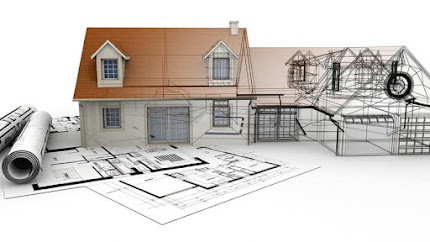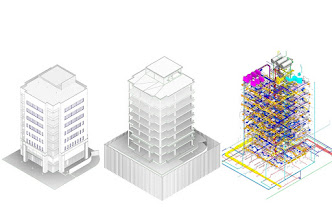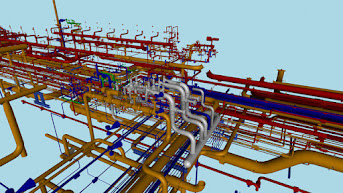The Importance of Architectural Design and Detailing Services in Construction Projects.
The building process involves more than just pouring concrete and erecting walls. It's a multifaceted process that calls for careful planning, inventiveness, and attention to detail. Architectural design and detailing services are essential to this procedure. To put it simply, this is the art and science of drawing up the specifications and drawings that direct a building's construction. We will discuss the value of architectural design and detailing services in building projects in this blog, as well as the reasons why these services are necessary to produce structures that are aesthetically beautiful, safe, and useful.
What is Architectural Drafting And Detailing?
The process of producing intricate technical drawings and plans for a building or other structure is known as architectural drafting and detailing. Architects, engineers, and construction workers can use these drawings as a guide to better understand how the structure should be built.
Creating accurate two-dimensional (2D) drawings that show the arrangement, measurements, and details of different building components, such as walls, windows, doors, and other architectural elements, is the process of drafting. This comprises sections, floor plans, elevations, and other features that offer a thorough grasp of the building.
Similarly, detailing is the process of including certain details in the plans, including the materials, measurements, and building methods. By using this information, contractors and builders may more precisely carry out the design and guarantee that the finished construction adheres to safety and building requirements while still fulfilling the architect's vision.
To put it another way, architectural drafting and detailing services are akin to producing a comprehensive blueprint or building instructions for constructing a home or other structure. It involves creating precise, lucid, and comprehensive blueprints that illustrate every facet of the building's construction and appearance.
Following are The Importance of Architectural Design and Detailing:
Designing for Functionality:
A building project's plan is similar to that of an architectural design. This is the first stage in which the building's vision is developed. At this stage, architects think about the building's function and design it to adhere to strict functional specifications. Every building, whether it be a house, workplace, school, or hospital, has a certain function and set of specifications.
An architect creating a hospital, for example, would plan the arrangement of operation rooms, patient rooms, and emergency exits. Conversely, a house architect will concentrate on making the kitchen, bedrooms, and living areas cozy. The building's ability to fulfill its intended purpose is guaranteed by the design process.
Aesthetics Matter:
Beyond usefulness, a building's visual appeal is greatly influenced by its architectural design. The goal of designers is to produce structures that are both aesthetically beautiful and functional. The surroundings and the people who interact with a structure can be greatly influenced by the way it looks.
Imagine an exquisite home in a serene suburban area or an impressive tower in a busy metropolis. These architectural wonders are recognizable icons because they not only serve their intended purposes but also improve the surrounding area. The goal of architectural design is to combine science and art to produce aesthetically pleasing, harmonious structures that endure.
Safety First:
Safety is the most important consideration in the building. Buildings with poor design can put nearby structures and their occupants at significant risk. Numerous safety considerations are taken into account in architectural design and detailing services.
For example, architects make sure that structures are strong enough to endure natural disasters like storms, floods, and earthquakes. Additionally, they take into account fire safety precautions, making sure that structures have the proper exits and fire-resistant materials. Aside from adequate ventilation, the architectural design also considers natural light and efficient plumbing.
Maximizing Space:
The secret to good architectural design is to maximize the amount of space that is available. Using their expertise, architects design practical plans that maximize the use of both indoor and outdoor space. This is especially crucial in urban settings where there is frequently a shortage of space.
For instance, architects must create structures in densely crowded cities that maximize site utilization while yet offering residents comfort and convenience. More housing, office, or retail space may be produced through clever design, which helps to meet the growing demand for urban expansion.
Cost Efficiency:
Cost-effectiveness is a key component of architectural design in addition to aesthetics. Architects can assist in controlling building costs by carefully designing the layout, materials, and construction techniques.
For example, an architect may suggest energy-efficient designs that result in lower utility expenses over the long run. They might also advocate for the use of environmentally friendly and perhaps less expensive sustainable building materials. Long-term time and financial savings are possible with careful planning.
Meeting Regulatory Requirements:
The engineering industry is highly regulated, requiring adherence to multiple building regulations, zoning rules, and safety standards. Services for architectural design and detailing are essential to guaranteeing that a building project conforms with all of these rules.
Architects ensure that the design satisfies all legal criteria because they have a thorough awareness of the regional building laws and regulations. If these requirements are not met, there may be delays, penalties, or even the project's demolition, which can be very expensive and time-consuming.
Communication with Stakeholders:
To ensure that all project stakeholders are communicating effectively, clear and detailed architectural designs are necessary. The vision and specifications of the project are communicated to contractors, engineers, and builders through these plans, which act as a common language.
The possibility of miscommunications or mistakes is decreased when all parties have access to comprehensive plans. As a result, there are fewer change orders, the building process goes more smoothly, and the project is eventually more successful.
Future-Proofing:
Future building requirements are taken into consideration in good architectural design. It's not just about the now; it's also about making sure the structure is still applicable and functioning in the future. Adaptability and sustainability can be increased in a structure through architectural design, whether it is for future expansions or to accommodate technological advancements.
Office buildings with flexible space designs, for instance, are easily able to adjust to changing work situations. Houses with energy-efficient architecture are more resilient to rising utility prices and growing environmental concerns in the future.
Essentially, it is impossible to overestimate the importance of architectural design and detailing services. They act as the driving force behind the transformation of an abstract concept into an actual, workable structure. Every stage of the process, from the original designs to the finished building, is carefully planned and carried out to guarantee that the building not only satisfies the client's requirements but also exceeds their expectations in terms of safety, beauty, and efficiency.
Furthermore, the promotion of ecologically responsible buildings has become increasingly dependent on architectural design due to the growing emphasis on sustainable and eco-friendly construction methods. Green building practices, energy-efficient designs, and sustainable materials are some of the ways that architects are helping the global movement to lessen the environmental effects of construction projects.
Furthermore, a community's cultural and social fabric is greatly enhanced by architectural design and detailing services. Community centers, public parks, and iconic landmarks are all the products of carefully considered architectural design that takes into account the requirements and goals of the users of these areas. Architects enhance a community's identity and sense of pride by designing buildings that speak to the local way of life and cultural legacy.
It's also important to note how the area of architectural design has changed as a result of technological breakthroughs. Architects may now build previously unthinkable sophisticated and comprehensive plans with the use of computer-aided design (CAD) software. Before construction even starts, clients and stakeholders may see the finished product thanks to 3D modeling and virtual reality tools, which promote better decision-making and increased confidence in the project's success.
The fundamental ideas of architectural design are still based on creativity, invention, and a thorough comprehension of human needs and behavior, even with the advantages of contemporary technology. Architects have to strike a balance between sustainability and safety, aesthetics and practicality, and client demands and legal obligations. A combination of technical proficiency, creative vision, and a clear awareness of the larger social and environmental context are needed for this delicate balancing act.
Let's sum up by saying that the foundation of each successful building project is architectural design and detailing. They make sure that structures are more than just things to erect; they are places that improve people's lives by being livable, safe, and sustainable. Architects have a significant influence on how the world is shaped, from the first conceptualization to the ultimate construction management. Along with having a long-lasting effect on the physical landscape, their work benefits communities all over the world in terms of social, cultural, and environmental well-being.
Thus, the next time you enter a building with thoughtful design, pause to recognize the skill, knowledge, and effort that went into making that area. It is evidence of the ability of architectural design and detailing services to shift the built environment into a manifestation of our shared values, aspirations, and future vision for a better, more sustainable society.
Read our latest blog on the - Building Information Modelling services



Comments
Post a Comment